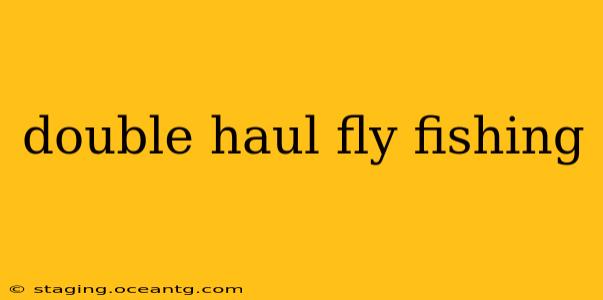Double hauling is a fundamental technique in fly fishing that significantly increases casting distance and accuracy. It's not just about throwing line; it's about mastering the delicate balance of power and timing to present your fly perfectly to the fish. This comprehensive guide will break down the intricacies of double hauling, answering common questions and helping you refine your technique.
What is Double Hauling in Fly Fishing?
Double hauling involves simultaneously pulling (hauling) on the fly line with your stripping hand while simultaneously pulling back on the rod with your casting hand. This coordinated action generates additional power and momentum, allowing you to cast further and more accurately than with a single-handed haul. It's a more advanced technique requiring practice and coordination but offers substantial rewards for the dedicated angler.
How Does Double Hauling Work?
The mechanics involve a simultaneous and coordinated movement between your casting and stripping hand. As you're completing your backcast, you begin to strip line in with your stripping hand. Simultaneously, you're pulling the rod back towards you with your casting hand. This coordinated effort loads the rod, storing energy that's then released during the forward cast, resulting in a longer, more powerful cast. The timing is critical; the haul must occur just before the rod straightens, allowing the stored energy to be unleashed efficiently.
Why is Double Hauling Important?
Mastering the double haul offers several key advantages:
- Increased Casting Distance: The added power generated allows you to reach fish further out, particularly important in larger rivers or when fishing from a distance.
- Enhanced Accuracy: The precise timing and control needed for effective double hauling translates to improved accuracy in placing your fly where it needs to be.
- Better Line Control: Double hauling gives you more control over your line, allowing you to mend effectively and manage your presentation to suit the water conditions.
- Presentation: A smoother, more controlled cast leads to a more natural presentation of the fly, crucial for enticing wary fish.
What are the Benefits of Learning to Double Haul?
The benefits extend beyond simply casting further. It elevates your fly fishing game in these ways:
- Improved Confidence: Mastering this skill instills confidence and competence in your ability to reach challenging targets.
- More Fishing Opportunities: You can access more fishing spots and reach fish that were previously out of reach.
- Greater Versatility: You become more adept at fishing in varying conditions, from windy situations to long casts on wide rivers.
- Enhanced Enjoyment: The refinement and precision involved makes the entire fly fishing experience more enjoyable.
How Can I Learn to Double Haul Effectively?
Learning to double haul takes time and patience. Here's a stepwise approach:
- Master the Basic Cast: Ensure you have a solid foundation in basic fly casting before attempting double hauling.
- Practice the Haul Individually: Start by practicing the stripping hand haul and the casting hand haul separately, focusing on the timing and rhythm.
- Combine the Movements: Gradually combine the two movements, aiming for a simultaneous, coordinated action.
- Start Slow: Begin with short casts and gradually increase the distance as your coordination improves.
- Seek Guidance: Consider taking lessons from an experienced fly fishing instructor to get personalized feedback and refine your technique.
- Practice Consistently: Regular practice is key to mastering this skill.
Is Double Hauling Necessary for All Fly Fishing Situations?
While a valuable skill, double hauling isn't always necessary. In close-quarters situations or with lighter lines, a single-handed haul might suffice. However, for longer casts and challenging conditions, it's an invaluable tool.
What are Common Mistakes When Double Hauling?
Beginners often struggle with:
- Poor Timing: The haul must be synchronized perfectly with the rod's movement.
- Uneven Hauls: The hauls should be smooth and consistent in both hands.
- Pulling Too Hard: Overpowering the cast can lead to inaccurate presentations.
- Lack of Practice: Consistent practice is crucial for refining this technique.
By understanding the mechanics, benefits, and potential pitfalls, you can confidently embark on your journey to mastering the double haul and significantly enhancing your fly fishing experience. Remember, patience and practice are key. With dedication, you’ll be effortlessly extending your reach and improving your accuracy in no time.
